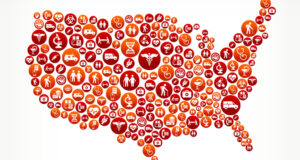
Community Health Workers — An Essential Workforce For Achieving Health Equity
Health equity is a fundamental goal in healthcare, aiming to ensure that everyone has a fair and just opportunity to be as healthy as possible. Community health workers (CHWs) play a crucial role in achieving this goal, by leveraging their unique skills and lived experience to bridge healthcare delivery gaps and address the social determinants of health. This article explores the role and value of CHWs, the current policy landscape underlying the provision of CHW services and offers practical actions case managers and others in the healthcare continuum can take to ensure CHWs are included in comprehensive strategies to achieve health equity.
UNDERSTANDING CHWS
CHWs are frontline public health workers who are trusted members of and/or have an especially close understanding of the communities and people that they serve (American Public Health Association [APHA], 2024). Depending on the population or community with whom they work, CHWs may be known by different titles, including community health representative in indigenous tribal communities, promotores in Spanish-speaking communities, or peer support specialists who utilize their lived experience to support individuals seeking treatment for mental health conditions or substance use disorders (Bureau of Labor Statistics [BLS], 2024). For purposes of this article, the title CHW is used to refer to the many diverse types of individuals serving in these vital roles.
CHWs are specifically skilled at closing access to care gaps that drive health inequities faced by members of their communities. While CHWs have long worked organically as connectors and advocates, they are increasingly recognized as an integral and distinct segment of the healthcare workforce. In fact, CHWs are now employed in a variety of settings including hospitals, outpatient clinics, health plans, public health departments and community-based organizations where they work closely with other healthcare and social service providers, including physicians, nurses, social workers, behavioral health providers and case managers (BLS, 2024).
CHWS AS HEALTH EQUITY AGENTS OF CHANGE
Historically marginalized and under-resourced populations including people of color, immigrants, individuals experiencing poverty and other populations impacted by systemic racism and discrimination are most affected by healthcare disparities (Kelly et al., 2021). Health equity involves addressing the social determinants of health, such as economic stability, education, social and community context, health and healthcare and neighborhood and built environment. CHWs work tirelessly to improve health outcomes among people who face these seemingly insurmountable barriers.
CHWs utilize a core set of skills and characteristics to effectively execute their roles as an indispensable member of the patient care team, including oral and written communication skills, cultural congruence, instructional capabilities, rapport building and critical thinking skills. Through their specialized skills and characteristics, CHWs are uniquely positioned to address the unique needs of members with whom they share lived experience by building trust within the community and empowering individuals to advocate for their needs.
CHWs’ trusting relationship and lived experience should be considered their superpower, the unique characteristics that enables a CHW to serve as an effective liaison between the members of their community and the various health and human services delivery systems, a superpower that is unmatched by other members of the healthcare workforce who do not have these same characteristics. This superpower cannot be taught; it is a part of who a CHW is as a member of their community. CHWs’ work results in the reduction of health disparities and promotes health equity by leveraging their keen understanding of the root causes of the barriers faced by members of their community and acting as frontline agents of change on behalf of those they serve (APHA, 2024).
CHWs’ value is displayed in their ability to build trust and rapport with the populations and individuals they serve, provide culturally competent care, enhance access to healthcare services and support disease management and prevention, all while reducing healthcare costs. Evidence continues to support the fact that CHW interventions reduce healthcare costs, prevent emergency department visits, increase primary care utilization and result in improved health outcomes and reduction in health disparities (Carson et al., 2022).
POLICY LANDSCAPE AND FUNDING FOR CHW SERVICES
The policy landscape for CHW benefits in the United States is evolving, with a growing number of states recognizing the value of CHWs and taking formal steps to integrate CHW services into Medicaid-funded programs. Twenty-four states currently fund CHW services through Medicaid, with an additional three states actively working toward implementing Medicaid coverage of CHW services (Connecticut Health Foundation, 2024). States are using a variety of approaches to pay for CHW services, including Medicaid state plan amendments, 1115 demonstration waivers and other managed care organization approaches (National Academy for State Health Policy, 2024).
Certification standards and training programs have been used to both validate and promote quality and consistency for CHWs as vital contributors in the healthcare delivery system. While not every state implementing CHW benefits through Medicaid has chosen to pursue certification, almost half of states have opted to define standard qualifications for CHW services through certification programs that are either implemented by the state or another entity, such as a state CHW association or third-party certification board (D’Alessandro, Higgins, & Wilkniss, 2024).
SUPPORTING THE CHW WORKFORCE
Despite their demonstrated value, CHWs face several challenges, including lack of recognition, insufficient funding and integration issues within healthcare delivery systems. Addressing these barriers will require ongoing collaborative efforts from policymakers, healthcare providers and organizations, as well as community members. Policies that support the integration and funding of CHWs are crucial for sustaining the availability of these services for underserved populations that stand to benefit most through the reduction of healthcare disparities driven by the work of CHWs. This includes recognizing CHWs as essential healthcare workers, expanding the availability of training and certification programs and ensuring stable funding through government and private sources.
Case managers and other healthcare professionals can take the following practical steps to support the CHW workforce and their patients who can benefit from the unique and valuable services CHWs provide in the pursuit of health equity goals:
- Conduct research on your state’s policy and funding landscape for CHW services;
- Learn about the availability of CHW services in your community (internal or external to your organization), including eligibility criteria and referral pathways;
- Refer and connect your patients to CHW services when available and appropriate;
- Seek out collaborative opportunities to work directly with CHWs to deliver patient-centered, culturally congruent care;
- Engage in activities to increase recognition and awareness of CHWs’ value within the healthcare delivery system;
- Increase support for CHW certification and training programs; and,
- Advocate at the organizational, local or state level for increased access to, availability of and funding for CHW services.
CHWs are indispensable in the pursuit of health equity. Their unique position within communities, combined with their specialized skills and lived experience, allows them to bridge gaps in healthcare delivery and effectively address the social determinants of health. By fostering trust, advocating for patients and providing culturally congruent care, CHWs play a pivotal role in reducing health disparities and promoting equitable health outcomes.
To fully leverage the potential of CHWs, it is essential that we find ways to sustainably integrate CHWs as recognized members of healthcare delivery teams, provide adequate training and resources and ensure sustainable funding for CHW services. By doing so, we can create a more inclusive, culturally responsive and effective healthcare system that truly serves all members of our society, paving the way for a healthier and more equitable future.
REFERENCES
American Public Health Association. (2024). Community Health Workers. Retrieved from https://www.apha.org/apha-communities/member-sections/community-health-workers.
Bureau of Labor Statistics, U.S. Department of Labor. (2024). Occupational Outlook Handbook: Community Health Workers. Retrieved August 29, 2024, from https://www.bls.gov/ooh/community-and-social-service/community-health-workers.htm.
Carson, S. L., Hong, C., Behforouz, H., Chang, E., Dixon, L. Z., Factor, D., George, S. M., Lewis, J., Majeno, A., Morales, M., Porter, C., Shah, A., Vassar, S. D., & Brown, A. F. (2022). Mechanisms for Community Health Worker Action on Patient-, Institutional-, and Community-Level Barriers to Primary Care in a Safety-Net Setting. The Journal of Ambulatory Care Management, 45(1), 22-35. https://doi.org/10.1097/JAC.0000000000000405.
Connecticut Health Foundation. (2024, January 31). 50-state scan of Medicaid payment for community health workers. Retrieved from https://www.cthealth.org/publication/50-state-scan-of-medicaid-payment-for-community-health-workers/.
D’Alessandro, M., Higgins, E., & Wilkniss, S. (2024, January 12). Trends in State Policies That Support the Community Health Worker Workforce. Retrieved from https://nashp.org/trends-in-state-policies-that-support-the-community-health-worker-workforce/.
Kelly, L., Benyo, A., Buck, L., Moses, K., Nuamah, A., & Opthof, E. (2021). Advancing California’s Community Health Worker & Promotor Workforce in Medi-Cal. California Health Care Foundation. Retrieved from https://www.chcf.org/resourcecenter/advancing-californias-community-health-worker-promotor-workforce-medi-cal/.
National Academy for State Health Policy. (2024, January 1). State Community Health Worker Policies. Retrieved from https://nashp.org/state-tracker/state-community-health-worker-policies/.
Image credit: ISTOCK.COM/FLASHVECTOR





